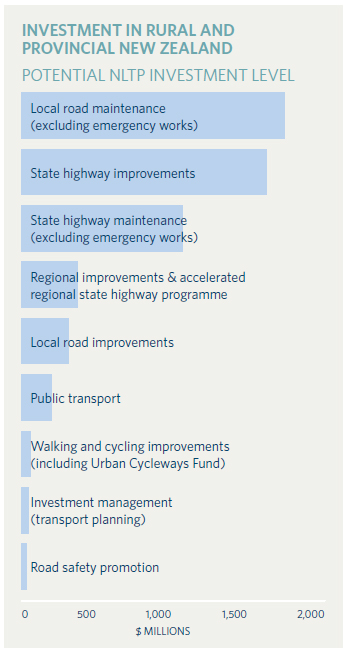New Zealand’s rural sector and provincial towns and cities are crucial to the country’s economic and social wellbeing. Rural industries are often referred to as the backbone of New Zealand’s economy because they generate more than one-third of the national GDP.
Rural areas are home to over 600,000 people, with over one million in provincial towns and cities. Given the often long distances and challenging terrain, the efficient, reliable and safe use of the transport system that connects these areas is vital. This is especially true for conveying perishable products and goods, such as milk and fruit, and for tourists seeking access to scenic locations.
Investment in rural and provincial transport is primarily focused on maintenance, safety and resilience.
Maintaining extensive rural networks with appropriate levels of service is an ongoing challenge for communities, with many rural areas having small rating bases and ageing populations. Furthermore, Statistics New Zealand’s population projections indicate that 15 rural territorial local authorities will experience a population decrease over the 2013–2031 period, mainly in the central and lower North Island. This could place additional pressure on the ability of these councils to generate the local funding share to maintain local networks and services.
The recent review of funding assistance rates recognised the challenges facing some rural areas and the need to set rates according to local circumstances. Higher rates are being applied for districts that would otherwise find it difficult to raise the revenue to provide a fit-for-purpose local transport network.
To ensure the needs of different transport users are met, the Transport Agency and local government have developed consistent levels of customer service across all parts of the road network in New Zealand. This enables consistent and fair investment decision making across the country.
Known as the One Network Road Classification (ONRC), this system has enabled councils to identify opportunities for efficiency gains, thereby delivering better value for money to ratepayers. An example is Queenstown Lakes District Council, which reviewed its maintenance programme and identified savings of approximately 25% in the 2015–18 NLTP programme.
The Transport Agency is continuing to work collaboratively with KiwiRail and other transport operators to deliver a transport system that is fit-for-purpose and connects all parts of the country. Overall, the recommended total investment in maintenance on the state highway and local road networks in the 2015–18 NLTP is around $4.8bn (including emergency works). This represents a 6% increase in the forecast from the 2012–15 NLTP, reflecting in part changes in demand on rural networks.
Given its size, terrain and population, New Zealand’s transport networks are, for the most part, fit for purpose and delivering effective levels of service. However, there are pinch points on the network and the Transport Agency is looking to prioritise improvements in these areas. An example is Northland, which is recommended to receive an increase of around $35m (22%) for local roads in the 2015-18 NLTP, to help manage the detrimental impact that increasing numbers of logging trucks are having on the region’s main freight routes. This up-front investment to provide appropriate levels of service on the Northland network will deliver long-term savings and avoid the risk of high expenditure on extensive road renewals.
While councils and the Transport Agency have been successful in reducing deaths and serious injuries on rural roads during the past 20 years, the improvements have levelled off in the last few years. Deaths and serious injuries continue to have a high social cost.
Rural areas tend to have a higher proportion of crashes for each kilometre travelled. The narrow nature of many rural roads and the undifferentiated speed limits that apply are less forgiving to driver error. Because rural networks are extensive, it is not cost-effective in most cases to try and improve safety through physical works. Instead, the focus is on working with the NZ Police and councils to target enforcement and safety promotions, and to initiate discussions about speed management in high-risk areas.
To deliver further reductions of deaths and serious injuries in rural areas, some of the issues the Transport Agency is proposing to address include:
NLTP investment in the regions, outside Auckland, Wellington and Christchurch, is being delivered through most activity classes and is shown in the table below. Some of this investment can be readily identified as targeted to these regions, being in the regional improvements activity class and Accelerated Regional State Highways Programme. Other investments for programmed activities, such as state highway maintenance, have been estimated.
The regional improvements activity class in the NLTP is targeting expenditure of $225m. All investment in this new activity class is planned to be in the state highway network, based on our expectation of local funding constraints.
Of the bids received for regional improvements, 45% are targeting safety outcomes, 37% economic growth and productivity outcomes, and 18% are focused on improved resilience outcomes.
About $310m is expected to be spent on local road improvements in rural and provincial areas. Of these investments, about 49% are targeting economic growth and productivity outcomes, 29% resilience and improved transport choice outcomes and 22% safety outcomes.
